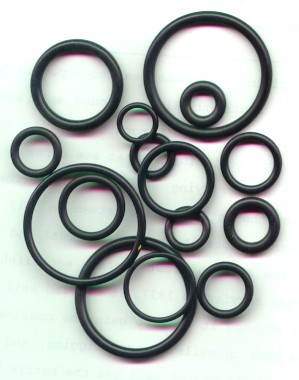O-Ring
Today, a combative old man changes technology. The University of Houston's College of Engineering presents this series about the machines that make our civilization run, and the people whose ingenuity created them.
Two things we've found in this series: Great inventors aren't always nice, pleasant people, and inventiveness does not attach to youth. Take Niels Christensen. He was harsh and uncompromising, and he gave us his finest invention when he was over 70.
I met that invention in 1951. I went from engineering school straight to the Boeing Company. Early in the game I had to design a valve. The valve stem had to slide inside a cylinder and seal in hydraulic fluid. An older engineer saw me trying to select a gasket. He said: "That's no way to do it. Use an O-ring." "What's an O-ring?" I answered.
O-rings had come into use only in WW-II. I'd never seen one in school. An O-ring is a skinny doughnut-shaped piece of rubber or neoprene that fits in a square slot. The way it works is subtle. As it mates with another surface, the ring distorts and drags a film of lubricant onto the surface. It also snugs down into one side of the slot and tightly seals against leakage.
Since then, those little rings have revolutionized sealing. They're so common today it's hard to imagine life without them.
Christensen, their inventor, was born in Denmark in 1865. He studied as a machinist, and he came to America in 1891. During the 1890s he invented a fine new air brake for electric streetcars. Soon he was up to his neck in litigation. His patent rights passed from company to company until Westinghouse owned them, and Christensen did not suffer injustice lightly.
So he fought through the courts, and he went on inventing. New gasoline engines, car and airplane starters, more braking systems! Then in 1933 he began looking at hydraulic system seals.
He experimented with rubber rings in slots. It took four years and a lot of testing to get it right. Christensen filed his first O-ring patent in 1937. He was 72 years old.
In 1941 he licensed the patent to United Aircraft. He was set to get rich. Then Pearl Harbor! The government bought out all the key military patents and gave them away to manufacturers. Christensen got a lump payment of $75,000, and O-rings belonged to the government. He mounted his last great court battle. It ended in 1971, 19 years after his death, with a $100,000 payment to his heirs.
How I hate these patent battle stories! They demean the creative process. Christensen gave us his greatest invention when he was 72. I want to remember him for changing the world after the world had begun to call him old. That's better payment than any of the people who stole his ideas ever got.
I'm John Lienhard, at the University of Houston, where we're interested in the way inventive minds work.
(Theme music)
Wise, G., Ring Master. American Heritage of Invention and Technology, Vol.7, No.1, Spring/Summer 1991, pp. 58-63.
